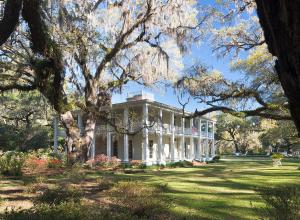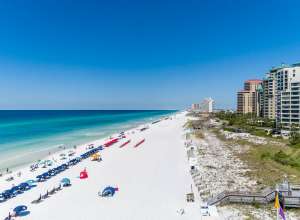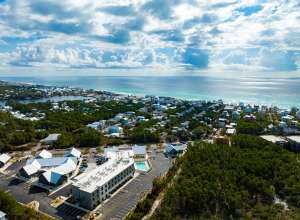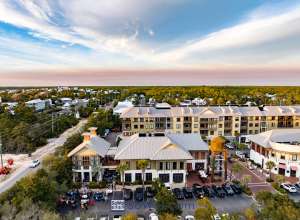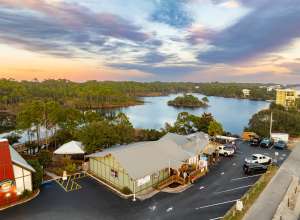Camp Helen State Park is bordered on three sides by the Gulf of Mexico and Lake Powell, one of the largest coastal dune lakes in Florida. Coastal dune lakes are extremely rare worldwide; in the United States they occur only along the Gulf Coast. Prehistoric middens and mounds indicate that humans lived in the area more than 4,000 years ago. From 1945 until 1987, Camp Helen was a company resort for employees of an Alabama textile mill and some of the buildings are now being restored. Natural areas range from coastal dunes and salt marshes along the Gulf to freshwater wetlands and sand pine scrub along the lake. Activities include swimming, beachcombing, nature study, hiking, and both freshwater and saltwater fishing. Camp Helen is located on the eastern border of Inlet Beach, just before the Lake Powell bridge.
Take a walk through Old Florida
Check out the nature trail on the north side of U.S. Highway 98. The path was designed with an over-sized walkway to accommodate most users whether hikers, bikers or those with special needs. The trail is just under a mile long and meanders around the north side of Camp Helen. An added feature is shaded rest areas with benches where visitors can stop to enjoy the views. The trail highlights many of the unique aspects of the park that is located alongside Lake Powell, one of the rare coastal dune lakes found in the South Walton area.
The south side of the park is also a treasure trove for first time and frequent visitors. Guests can swim, fish and hike, while enjoying habitats that include white, sandy beaches, lake front vistas and wetlands. The renovated and repaired lodge, water tower and rainbow cottages located on this side of the park provide glimpses of life as it was in Old Florida.
History and Culture
Prehistoric middens (trash heaps) and mounds have been found within the park, suggesting humans have been in the area for approximately 400 years. Camp Helen State Park was originally known as Inlet Beach to early European settlers and later to developers. The area around Phillips Inlet was initially developed for recreational opportunities in the early 1920’s, with a lodge and associated buildings being added to the property in the 1940’s. Some of these buildings can still be seen today, and give an insight into tourist life along the Gulf Coast back in the day. From 1945 all the way to 1987, Avondale Textile Mills of Sylacauga, Alabama operated Camp Helen as a resort for vacationing employees.
Thanks to the efforts of the local community, Gulf Coast Community College, and the Florida Department of Environmental Protection, Camp Helen was acquired by the State of Florida in 1994 under the Conservation and Recreational Lands Programs, and today offers visitors a first-class state park.
In 1928 Robert E. Hicks purchased 185 acres of land overlooking Philips Inlet, where he built a summer home for his wife, Margaret, who named the compound Loch Lomond. Construction of the historic lodge and associated buildings was completed before the 1940s. In 1945 Avondale Textile Mills of Sylacauga, Alabama purchased Loch Lomond from the Hicks family, renamed the property Camp Helen, and for 39 years operated a resort destination for their vacationing employees. During that time, 12 duplex cottages and a recreation hall were built. These historic buildings still exist today.
The Rainbow Cottages, originally built by the Hicks Family during the 1930s, are best known for their use during the Avondale Mills years. Avondale Mills bought the Camp Helen property from Mrs. Hicks with the intention of creating a recreational area for their company employees. Avondale Mills began using the Rainbow Cottages and then added other cottages and duplexes for lodgings for their employees. The Rainbow Cottages were so named because they were painted a variety of rainbow colors, each one different.
All were furnished simply and colorful handmade octagonal stones created the sidewalk in front of the cottages. Sitting on the bluff overlooking Lake Powell, the cottages were the most sought-after lodgings at Camp Helen, sleeping two to four people in each. The smallest cottage was basically a 291 square-foot studio; the largest cottage had two small bedrooms. The Rainbow Cottages were the only buildings on the property that retained their original purpose as guest houses welcoming the vacationing visitor. Employees at Avondale Mills’ various locations throughout the Southeast waited anxiously each year for the lottery results announcing who had been picked to go to Camp Helen that year. Transportation was provided to Camp Helen and all recreational activities were free, including boating, water skiing and fishing trips for loads of family fun.
Robert and Margaret Hicks purchased the Camp Helen property in the 1930s. Mrs. Hicks called their home Loch Lomond. The lodge itself was started in 1931 and completed about a year later. Originally intending to make it their summer home, Mrs. Hicks made it her permanent home a year later when her husband died. She meant for it to be her private residence but the death of her husband accompanied, by the Great Depression forced her to accommodate paying guests on her property. She maintained the lodge as her private residence but employed a caretaker to manage the newly-built Rainbow Cottages for guests.
Mrs. Hicks sold the property to Avondale Mills in 1945 and with the transfer of ownership also came the transfer of use. The lodge became a public space housing top-level Avondale Mills’ management personnel and others. Avondale Mills operated Camp Helen as a recreation area from 1945 through 1987. The Camp Helen story might have ended there were it not for persistent area residents who believed the space should become a state park. In 1996, their dream became a reality and today the Big House, as it is affectionately called now, welcomes visitors to Camp Helen State Park.
Rising above surrounding vegetation, the Camp Helen Water Tower has served as a landmark, both by sea and by land, of Camp Helen for more than 70 years. The Hicks family originally built the large water tower and accompanying pump house in the 1930s to provide additional water needed by guests at the Rainbow Cottages.
The tower, standing 40 feet above the level of the pump house, housed a cistern tank capable of holding 1,000 gallons of water and ensuring adequate water pressure for all who needed it. Two large electric generators, located in the pump house, powered the well pump and produced electricity for the entire property. In the years since the tower was first erected, the tank has sported many new coats of paint. The entire structure was renovated and refurbished when the state of Florida purchased the property, preserving this icon for future generations.
The Hicks family built a gazebo on the edge of the bluff in front of their house in the 1930s, matching the design of the gazebo to that of the lodge. When Avondale Mills purchased the property, they removed the log-siding to create an open gazebo and made it the entrance to the steps leading to the boathouse and dock. Although the gazebo still stands, the boathouse, dock and staircase were destroyed by hurricanes in 1975 and 1995.
Today remnants can be seen of the original pilings that supported the boathouse and the concrete staircase has been replaced with a new wooden one. The boathouse was the starting point for many a fun activity since Avondale Mills maintained a variety of boats for their guests. They offered activities such as fishing, sailing, motor boating and water skiing on Lake Powell, the coastal dune lake surrounding Camp Helen on two sides. The dock was also the departure point for many fishing trips in the Gulf of Mexico. Philips Inlet connects Lake Powell to the gulf allowing visitors to go directly from the lake to the gulf when the inlet is open.
Visitors on beach One of Camp Helen’s other best known landmarks was the pier on the gulf. Built by Avondale Mills for its guests, visitors enjoyed fishing for sharks from the pier as well as taking leisurely sunset strolls. Though badly ravaged by time, the historic pier still partially stands today as a reminder of another time in Florida’s past. As you can see by this historic photo from a 1956 edition of the Avondale Sun, a company newspaper, the pier stood proud and ready to welcome the season’s guests back to Camp Helen.
It is said that people who visited Camp Helen came as strangers but left as friends. Though it is quieter now, Camp Helen State Park is proud to carry on the tradition today by welcoming scores of visitors to the park to fish, hike, bird watch and kayak, as well as learn about a little-known time and place in Florida's recreational history.
Where Exactly Is It? Camp Helen State Park is located at 23937 Panama City Beach Parkway, just west of the Phillips Inlet Bridge on the Bay County and Walton County line. The park is bordered on three sides by the Gulf of Mexico, Phillips Inlet, and Lake Powell, which is one of the largest coastal dune lakes in Florida. The great thing about Camp Helen is that it has it all – wooded nature trails, tranquil lake scenery, and an expansive, open white-sand beach. When you’re here, you feel like you are one with the outdoors, thanks to the natural beauty that surrounds you at every turn, and the peace and quiet that is so hard to find in the more developed spots in the area.
What Can I Do There?
The opportunities for outdoor recreation are unlimited at Camp Helen State Park. Wildlife viewing is extremely popular, as the three different water bodies have created a diverse habitat for wildlife that includes rare shorebirds and Bald Eagles. Camp Helen is a great fishing spot for both fresh and saltwater species, and the park provides numerous nature trails for hiking. Visit the lodge and relax in the rocking chairs overlooking Lake Powell, or head to the beach for swimming, beachcombing, tanning or boating. Camp Helen State Park is open from 8:00 am until sundown, 365 days a year. The admission fee is $4.00 per vehicle with a maximum of 8 passengers, or $2.00 for pedestrians, bicyclists, extra passengers, or passengers in a vehicle with a holder of an annual individual entrance pass.
How Can I Get Involved?
For those who have some spare time on their hands and would like to give back to the community, Camp Helen State Park always welcomes volunteers. A volunteer can do many things, including greeting visitors, conducting tours, helping Park Rangers remove exotic plants or simply maintaining the natural beauty of the beach, waterways or trails. If you are interested, stop by on any Thursday morning about 9:00 am or pick up an application in the visitor center.
Video
Map of this Location


